
Mortellaro's Nursery
Shrubs, trees, ground covers, native plants, and seasonal color
Wholesale Only
Click on any of the alpha indexes below to view the corresponding lists of plants.
The default list is displayed alphabetically by common name for all plant types. You can view the plants by clicking on the Scientific Name or limit the plant type by using the drop down.
Plants actively being grown for the current season are shown -- selecting Discontinued Items will show plants we have offered in the past.

|
CelosiaBotanical Name: Celosia argentea
Celosia (Annual) is a vibrant, heat-loving plant prized for its unique, feathery or crested blooms in shades of red, yellow, orange, and pink. It thrives in Texas landscapes, offering season-long color from spring until the first frost. As a fast-growing annual, it is widely used in borders, containers, and mass plantings, where its bright flowers provide high-impact visual appeal. Celosia prefers full sun and well-draining soil, tolerating both acidic and alkaline conditions. Once established, it is drought tolerant, though regular watering encourages stronger growth and more prolific blooms. It is deer resistant and attracts pollinators like bees and butterflies, making it an excellent addition to wildlife-friendly gardens. Reaching a mature size of 12-18 inches tall and 10-12 inches wide, Celosia is ideal for compact plantings where space is limited. When planting in groups, spacing of 10-12 inches apart allows for proper air circulation and encourages healthy growth. Though it does not typically reseed reliably in Central Texas, occasional volunteer seedlings may appear the following season in favorable conditions. As an annual in USDA Zones 2-11, Celosia thrives in warm climates but does not survive freezing temperatures. Once cold weather arrives, plants will die back and need to be replanted in spring for another season of blooms. Cultivars 2025 'Bright Sparks Mix' [ More Info ]
|
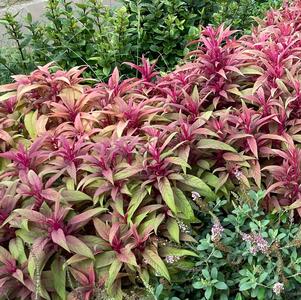
|
Celosia Dragon's BreathBotanical Name: Celosia argentea plumosa 'Dragons Breath®'
Dragon’s Breath Celosia (Celosia argentea plumosa 'Dragon’s Breath') is a striking annual that thrives in Central Texas, known for its dramatic deep red foliage and feathery crimson blooms. Though not a perennial in this region, it performs exceptionally well in warm climates, bringing bold color to garden beds, borders, and containers. It is heat and drought tolerant, making it a reliable choice for summer landscapes. This celosia prefers full sun and well-draining soil but is adaptable to both acidic and alkaline conditions. In hotter summers, it appreciates some afternoon shade. It is relatively deer resistant and non-toxic, making it a great addition to pet-friendly gardens. It also attracts pollinators like bees and butterflies, enhancing garden biodiversity. Dragon’s Breath grows to a height of 18 to 24 inches with a spread of 12 to 18 inches. When planting in groups, spacing of at least 12 inches ensures adequate air circulation and promotes healthy growth. While it does not reliably reseed in all climates, some volunteers may appear the following year in warmer regions if conditions are favorable. [ More Info ]
|
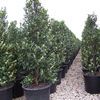
|
Cherry Laurel, CompactBotanical Name: Prunus caroliniana 'Compacta'
Compact Cherry Laurel offers an excellent solution for landscaping in the diverse soil conditions of Texas. This Texas-Native evergreen shrub not only thrives in slightly acidic soils but has good tolerance for alkaline soils, making it adaptable to the varying pH levels commonly found throughout the state. Its versatility in soil preference allows for widespread cultivation in gardens, parks, and urban landscapes across Texas, providing year-round beauty and functionality. Compact Cherry Laurel boasts a robust growth habit, making it an ideal choice for creating dense hedges or privacy screens. When planting in rows, spacing each shrub approximately 3 to 6 feet apart ensures proper airflow and ample room for growth while allowing for customization based on desired density. Cherry Laurel prefers full sun, but can grow in shaded areas, although will not have as dense foliage. Furthermore, Compact Cherry Laurel exhibits deer-resistant properties, making it particularly well-suited for regions where deer browsing poses a challenge to gardeners. Its aromatic foliage deters deer while providing an attractive backdrop of glossy green leaves year-round. Small fragrant white flowers appear in late winter to early spring, followed by black berries that ripen in the summer and provide food to wildlife. [ More Info ]
|

|
Coleus, MixedBotanical Name: Coleus x
Popular fast growing bedding plant for the summer that does best in filtered to full shade. Attractive foliage is opposite and simple, ovate leaves. Come in shades of yellow, dull red, purple, and pale green. Flowers are dark blue to cream, displayed in terminal spike-like racemes that reach three inches long. Coleus needs loose, well drained fertile soil, and does well as an underplanting. Mealy bugs are a problem when grown in full shade, and frequent trimming will ensure a thick bushy plant. 2010 Spring - Summer Cultivars : Burgundy Sun [ More Info ]
|

|
Cone FlowerBotanical Name: Echinacea purpurea '2 Available, See Description'
Coneflower (Echinacea) is a hardy perennial known for its vibrant, daisy-like flowers and resilience in a variety of garden settings. Popular for its long blooming season from summer to fall, it thrives in full sun and well-drained soil, making it an excellent choice for drought-tolerant landscapes. Coneflowers are also attractive to pollinators like bees and butterflies and are deer resistant, adding ecological and aesthetic value to gardens. Two notable cultivars are PowWow and Artisan Red. The PowWow series, particularly 'PowWow Wild Berry,' is celebrated for its vibrant magenta-pink flowers and compact growth, reaching about 16-24 inches in height. It is known for its prolific blooming and excellent heat and drought tolerance. The Artisan Red cultivar offers striking red-orange flowers, providing a bold color contrast in garden beds. Both cultivars maintain the robust, low-maintenance qualities of the coneflower, making them popular choices for gardeners seeking vibrant, resilient plants. [ More Info ]
|
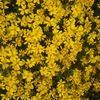
|
Copper Canyon DaisyBotanical Name: Tagetes lemmonii
Copper Canyon Daisy is a hardy perennial shrub celebrated for its bright yellow, daisy-like flowers and finely textured, aromatic foliage. A native of the southwestern U.S. and Mexico, this drought-tolerant plant thrives in Texas landscapes, particularly in Central, South, and West Texas. It reaches a mature height of 3 to 4 feet and spreads 4 to 6 feet, forming a rounded shape that fits well in xeriscapes, borders, or mass plantings. Copper Canyon Daisy performs best in USDA Zones 8 through 11, flourishing in full sun and well-drained soils. This plant adds vibrant color to gardens during its primary blooming period in the fall and has a lighter bloom period in the spring. Its fragrant foliage naturally deters deer, making it a great choice for areas with high deer pressure. Copper Canyon Daisy prefers slightly alkaline to neutral soils and tolerates poor drainage to some extent, though overly wet conditions should be avoided. Its flowers attract butterflies and other pollinators, adding further ecological value to Texas landscapes. While Copper Canyon Daisy is non-toxic, its strongly scented leaves may irritate sensitive skin when handled. Space plants about 3 to 4 feet apart to accommodate their mature size and ensure proper airflow. The plant's bold yellow blooms and feathery foliage make it an excellent choice as a focal point or in mixed perennial beds for a pop of texture and color. In winter, Copper Canyon Daisy is semi-evergreen in milder areas but may die back to the ground in colder regions after a hard freeze. Mulching around the base helps protect the roots, and pruning frost-damaged stems in early spring promotes vigorous regrowth as the weather warms. [ More Info ]
|
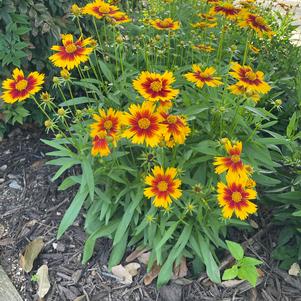
|
CoreopsisBotanical Name: Coreopsis UPTICK Gold & Bronze 'Baluptred'
Coreopsis Uptick Gold & Bronze is a delightful plant that is prized for its vibrant and showy blooms. The Uptick Gold & Bronze variety of Coreopsis has a compact and upright habit that grows up to 12-18 inches tall and spreads up to 12-16 inches wide. The leaves are lance-shaped and have a bright green color that forms a dense, bushy mound. The foliage is attractive even when the plant is not in bloom. The flowers of Coreopsis Uptick Gold & Bronze are the main attraction. They bloom profusely from early summer until fall, producing clusters of bright golden-yellow flowers with a bronze-red center. The flowers are 1-2 inches wide and have a distinctive daisy-like appearance. They are held atop sturdy stems that are well-suited to cutting for use in floral arrangements. Coreopsis Uptick Gold & Bronze is an easy-to-grow plant that thrives in full sun to partial shade and well-draining soil. It is drought-tolerant and can withstand some humidity. The plant is relatively low-maintenance and does not require much pruning or fertilization. Deadheading spent blooms will encourage continuous blooming throughout the growing season. [ More Info ]
|
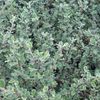
|
Cotoneaster, GrayleafBotanical Name: Cotoneaster glaucophyllus
Often mispronounced as the two separate words Coton and Easter, Cotoneaster is one of the more durable and hardy landscape shrubs for the Texas landscape. It tolerates urban conditions, poor soils, and even drought – but thrives when given favorable care. It has an appealing shade of gray-green foliage that is slightly pubescent, arranged on low arching branches that somewhat form a thicket. The small leaves and compact form allow to be pruned into thick hedges easily. Clusters of small white flowers appear on the branches throughout the spring, and are followed by red berries that persist throughout the fall. [ More Info ]
|

|
Crape Myrtle, BashamBotanical Name: Lagerstroemia indica x fauriei 'Basham'
Basham’s Party Pink Crape Myrtle (Lagerstroemia indica x fauriei 'Basham's Party Pink') is a fast-growing, large crape myrtle hybrid known for its soft pink flowers, smooth exfoliating bark, and excellent heat tolerance. It is one of the tallest crape myrtles, making it a great choice for shade, street plantings, or large specimen trees in Texas landscapes. Blooming from early summer to fall, it provides months of color and thrives in full sun. This hybrid variety prefers well-draining, slightly acidic to neutral soil, though it can tolerate a range of conditions. It is highly drought tolerant once established but benefits from occasional deep watering in extended dry spells. Resistant to powdery mildew, this cultivar requires less maintenance than older crape myrtle selections. Deer tend to avoid it, making it a reliable option for urban and residential landscapes. Basham’s Party Pink Crape Myrtle reaches a mature height of 30-40 feet with a spread of 20-30 feet, making it one of the largest crape myrtles available. When planting multiple trees, spacing of 15-20 feet apart ensures proper canopy development. Compared to other crape myrtles, it grows rapidly and develops an attractive, wide-spreading canopy that provides light shade. In USDA Zones 7-10, Basham’s Party Pink is cold-hardy but deciduous, shedding its leaves in winter to reveal striking, mottled bark. It requires minimal winter care in Texas, though young trees benefit from mulch around the base in colder regions. Pruning in late winter or early spring helps shape the tree and promote new growth for maximum flowering. [ More Info ]
|

|
Crape Myrtle, DynamiteBotanical Name: Lagerstroemia indica 'Dynamite'
Dynamite Crape Myrtle (Lagerstroemia indica 'Dynamite') is a striking crape myrtle variety known for its vibrant, deep red blooms and upright growth habit. One of the most intense red-flowering crape myrtles available, it blooms from early summer through fall, making it a standout in any Texas landscape. This variety is a popular choice for specimen trees, street plantings, and privacy screens, thanks to its dense canopy and strong branching structure. Dynamite Crape Myrtle thrives in full sun and well-draining soil, tolerating both acidic and alkaline conditions. It is highly drought tolerant once established but benefits from occasional deep watering during prolonged dry spells. This cultivar is resistant to powdery mildew and other common crape myrtle diseases, making it a low-maintenance choice for homeowners and landscapers. Deer typically avoid it, adding to its resilience. This variety grows to a mature height of 15-20 feet with a spread of 10-15 feet, forming a rounded canopy. When planting in rows or as a grouping, spacing of 10-15 feet apart allows for proper air circulation and healthy growth. Unlike some crape myrtles that fade over time, the blooms of Dynamite maintain their bold red color throughout the season. Compared to Red Rocket Crape Myrtle, another red-flowering variety, Dynamite has a more compact and rounded growth habit, while Red Rocket tends to grow slightly taller and less wide - generally. The columnar form, making it a better choice for narrower spaces. While both varieties feature rich red flowers, Red Rocket’s blooms may appear slightly lighter in some conditions, whereas Dynamite retains its deep red coloration more consistently. Both varieties share similar heat tolerance and disease resistance, but Dynamite is often preferred for medium-height plantings, while Red Rocket works better for taller landscape focal points. In USDA Zones 7-10, Dynamite Crape Myrtle is cold-hardy but deciduous, dropping its leaves in winter to reveal attractive exfoliating bark. It requires minimal winter care, though mulching young trees can provide insulation in colder areas. Pruning in late winter or early spring helps encourage vigorous new growth and abundant flowering. [ More Info ]
|
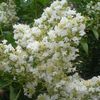
|
Crape Myrtle, NatchezBotanical Name: Lagerstroemia indica x fauriei 'Natchez'
Natchez Crape Myrtle (Lagerstroemia indica x fauriei 'Natchez') is a fast-growing, white-flowering crape myrtle hybrid known for its smooth cinnamon-brown exfoliating bark, broad canopy, and outstanding disease resistance. It is one of the tallest crape myrtles, making it an excellent choice for shade trees, street plantings, and large focal points in the landscape. This variety thrives in full sun and well-draining soil, tolerating both acidic and alkaline conditions. It is highly drought-tolerant once established and resistant to powdery mildew and common crape myrtle diseases. Natchez Crape Myrtle grows 30-35 feet tall and 20-25 feet wide, forming a graceful, arching canopy. For proper spacing, plant 15-20 feet apart. In USDA Zones 7-10, Natchez is cold-hardy but deciduous, shedding its leaves in winter. Young trees benefit from mulching around the base for root insulation in colder areas. [ More Info ]
|

|
Crape Myrtle, Pink VelourBotanical Name: Lagerstroemia indica 'Pink Velour'
Pink Velour Crape Myrtle (Lagerstroemia indica 'Pink Velour') is a medium-sized crape myrtle prized for its rich pink flowers and striking deep burgundy foliage that emerges in spring. As the season progresses, the leaves transition to a dark green hue, creating a beautiful contrast against the vivid pink blooms that appear from early summer through fall. This variety is an excellent choice for accent plantings, privacy screens, or small specimen trees in Texas landscapes. Pink Velour thrives in full sun and well-draining soil, tolerating both acidic and alkaline conditions. It is highly drought tolerant once established but benefits from occasional deep watering during prolonged dry spells. This cultivar is resistant to powdery mildew and other common crape myrtle diseases, making it a low-maintenance choice for homeowners and landscapers. Deer typically avoid it, adding to its resilience. This variety grows to a mature height of 10-15 feet with a spread of 8-12 feet, making it smaller than many other crape myrtle varieties. When planting in rows or as a grouping, spacing of 8-12 feet apart ensures proper air circulation and healthy growth. Compared to larger crape myrtles, Pink Velour is an excellent choice for smaller landscapes and urban gardens, where its controlled growth and rich foliage color add visual interest. In USDA Zones 7-10, Pink Velour Crape Myrtle is cold-hardy but deciduous, dropping its leaves in winter to reveal attractive exfoliating bark. It requires minimal winter care, though mulching young trees can provide insulation in colder areas. Pruning in late winter or early spring helps encourage vigorous new growth and abundant flowering. [ More Info ]
|
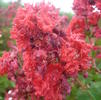
|
Crape Myrtle, RedBotanical Name: Lagerstroemia indica
Crape Myrtle (Lagerstroemia indica) is a staple of Southern landscapes, known for its long-lasting summer blooms in shades of pink, red, purple, and white. Though it lacks the powdery mildew resistance found in newer cultivars, it remains popular due to its adaptability and striking floral display. It thrives in Texas landscapes, tolerating heat, drought, and poor soils once established. This deciduous tree or large shrub is an excellent choice for ornamental planting, street trees, or privacy screens. Crape Myrtles prefer full sun and well-draining soil, though they tolerate a range of soil types, including both acidic and alkaline conditions. They are relatively deer-resistant and do not have toxic properties, making them a safe choice for residential gardens. Regular pruning encourages a strong structure and prolific blooming, but avoid over-pruning, which can lead to weak growth and fewer flowers. These trees bloom on new wood, so late winter pruning is ideal. One distinguishing feature of Crape Myrtles is their range of growth habits. The standard non-cultivar versions can reach anywhere from 10 to 25 feet tall with a spread of 8 to 20 feet. There are other cultivars available that can exceed these sizes, or others to be much smaller. When planting in a row or grouping, space the standard non-cultivars 8 to 12 feet apart. During winter, Crape Myrtles are fully deciduous, dropping their leaves to reveal striking exfoliating bark in shades of cinnamon, gray, or brown. In Texas, they generally do not require winter protection, as most varieties are hardy to USDA zones 7-10. However, young trees may benefit from a layer of mulch around the base to insulate the roots in colder northern regions of the state. [ More Info ]
|
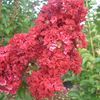
|
Crape Myrtle, Red RocketBotanical Name: Lagerstroemia indica 'Red Rocket'
Red Rocket Crape Myrtle (Lagerstroemia indica 'Red Rocket') is a fast-growing crape myrtle variety prized for its bright red blooms and tall, upright growth habit. Blooming from early summer through fall, this variety provides a long-lasting display of color and is a standout choice for large landscape plantings, privacy screens, or street trees. Its ability to grow taller than many other crape myrtles makes it ideal for areas where height is a priority. Like other crape myrtles, Red Rocket thrives in full sun and well-draining soil, tolerating both acidic and alkaline conditions. Once established, it is highly drought tolerant but benefits from occasional deep watering to maintain peak performance. It is also resistant to powdery mildew and other common crape myrtle diseases, making it a low-maintenance landscape choice. Deer typically avoid it. Red Rocket reaches a mature height of 15-20 feet with a spread of 10-15 feet, making it one of the taller red-flowering crape myrtles. When planting in rows or as a grouping, spacing of 10-15 feet apart ensures optimal air circulation and canopy expansion. Compared to other red-flowering crape myrtles, it is one of the fastest-growing selections, reaching its mature size quickly. Compared to Dynamite Crape Myrtle, Red Rocket has a taller and more upright growth habit, making it well-suited for narrower spaces or areas where height is needed. While both varieties boast vibrant red blooms, Red Rocket’s flowers may appear slightly lighter in color in certain conditions, while Dynamite retains a consistently deep red hue. Dynamite also forms a more rounded and compact canopy, making it a better choice for smaller landscapes or medium-sized plantings. In USDA Zones 7-10, Red Rocket is cold-hardy but deciduous, dropping its leaves in winter to reveal smooth, exfoliating bark. Minimal winter care is required, though mulching around the base of young trees can help insulate roots in colder areas. Pruning in late winter or early spring encourages strong new growth and maximum bloom production. [ More Info ]
|
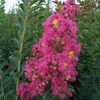
|
Crape Myrtle, TuscaroraBotanical Name: Lagerstroemia indica 'Tuscarora'
Tuscarora Crape Myrtle (Lagerstroemia indica 'Tuscarora') is a standout variety known for its vibrant coral-pink blooms and superior resistance to powdery mildew. It thrives in Texas landscapes, offering a long flowering season from summer to early fall. Like other Crape Myrtles, it is highly adaptable to heat, drought, and various soil conditions once established, making it an excellent choice for ornamental planting, street trees, or privacy screens. This variety prefers full sun and well-draining soil, though it can tolerate both acidic and alkaline conditions. Tuscarora Crape Myrtle is relatively deer-resistant and non-toxic, making it a safe choice for residential gardens. Proper pruning in late winter helps maintain its structure and encourages prolific blooming, as flowers develop on new wood. Tuscarora Crape Myrtle grows as a medium to large tree, reaching 20 to 25 feet in height with a spread of 15 to 20 feet. Its strong branching structure and uniform canopy make it an excellent specimen tree. When planting in a row or grouping, space trees 15 to 20 feet apart to allow for proper air circulation and canopy development. During winter, this variety is fully deciduous, shedding its leaves to reveal beautiful exfoliating bark in shades of cinnamon and gray. It is hardy to USDA zones 7-10 and does not typically require winter protection in Texas. However, young trees benefit from a layer of mulch around the base to insulate the roots in colder areas. [ More Info ]
|
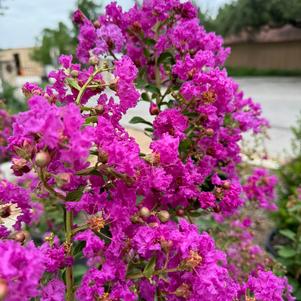
|
Crape Myrtle, TwilightBotanical Name: Lagerstroemia indica 'Twilight'
The Twilight Crape Myrtle is highly suitable for Texas landscapes due to its robust adaptability and striking visual appeal. Its deep purple flowers, which bloom from mid-summer to fall, provide extended seasonal color. This makes it an excellent choice for adding vibrant contrast in garden designs, either as a standalone specimen or within mixed borders. From a practical standpoint, the Twilight Crape Myrtle is exceptionally drought-tolerant and thrives in Texas' hot, sunny climate. It requires minimal irrigation and adapts well to various soil types, including clay and sandy loam. Its resistance to common pests and diseases, such as powdery mildew and aphids, reduces maintenance needs, making it a reliable option for sustainable landscaping in the region. Additionally, the Twilight Crape Myrtle supports local ecosystems by attracting pollinators like bees and butterflies. Its distinctive peeling bark adds winter interest and provides habitat for small wildlife. Incorporating this tree into urban and suburban landscapes can enhance ecological diversity and resilience, offering both aesthetic and environmental benefits in the challenging Texan climate. [ More Info ]
|
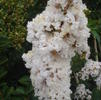
|
Crape Myrtle, WhiteBotanical Name: Lagerstroemia indica
Crape Myrtle (Lagerstroemia indica) is a staple of Southern landscapes, known for its long-lasting summer blooms in shades of pink, red, purple, and white. Though it lacks the powdery mildew resistance found in newer cultivars, it remains popular due to its adaptability and striking floral display. It thrives in Texas landscapes, tolerating heat, drought, and poor soils once established. This deciduous tree or large shrub is an excellent choice for ornamental planting, street trees, or privacy screens. Crape Myrtles prefer full sun and well-draining soil, though they tolerate a range of soil types, including both acidic and alkaline conditions. They are relatively deer-resistant and do not have toxic properties, making them a safe choice for residential gardens. Regular pruning encourages a strong structure and prolific blooming, but avoid over-pruning, which can lead to weak growth and fewer flowers. These trees bloom on new wood, so late winter pruning is ideal. One distinguishing feature of Crape Myrtles is their range of growth habits. The standard non-cultivar versions can reach anywhere from 10 to 25 feet tall with a spread of 8 to 20 feet. There are other cultivars available that can exceed these sizes, or others to be much smaller. When planting in a row or grouping, space the standard non-cultivars 8 to 12 feet apart. During winter, Crape Myrtles are fully deciduous, dropping their leaves to reveal striking exfoliating bark in shades of cinnamon, gray, or brown. In Texas, they generally do not require winter protection, as most varieties are hardy to USDA zones 7-10. However, young trees may benefit from a layer of mulch around the base to insulate the roots in colder northern regions of the state. [ More Info ]
|
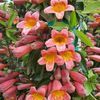
|
CrossvineBotanical Name: Bignonia capreolata 'Tangerine Beauty'
A Texas native semi-evergreen vine that climbs fences, trellises, and trees easily with its small tendrils. It can reach lengths up to 40 feet, easily attracting hummingbirds and butterflies throughout the blooming season. 'Tangerine Beauty' is a cultivar reintroduced by J.C. Ralston of the University of North Carolina. The flowers are borne in clusters, each being pinkish-red with an orange-yellow throat. The bright green leaves turn an attractive red to purple hue in the winter after the first cold front. . Crossvine is somewhat drought and poor soil tolerant, exhibiting no pest issues. [ More Info ]
|
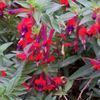
|
Cuphea, Bat FaceBotanical Name: Cuphea llavea
Bat-Faced Cuphea, known for its uniquely shaped flowers resembling tiny bat faces, is a charming addition to Texas gardens. This semi-woody perennial, native to Mexico, thrives in warm climates and is valued for its vibrant red and purple blooms, which persist from late spring through fall. Its compact size and whimsical appearance make it suitable for borders, containers, or as an accent plant in flower beds. This plant performs best in full sun to partial shade, with sufficient sun encouraging more prolific blooms. It is adaptable to a range of well-draining soils, including neutral to slightly acidic conditions – but prone to root rot when in poor draining areas. While not specifically a Texas native, Bat-Faced Cuphea is well-suited to the state's hot and humid environment. It is non-toxic and somewhat deer resistant, offering an excellent low-maintenance option for landscapes. Bat-Faced Cuphea grows to about 12 to 18 inches tall, with a similar spread. Space plants 12 to 18 inches apart for a dense, vibrant display. Regular watering will help it thrive, but the plant has moderate drought tolerance once established. Its nectar-rich flowers attract hummingbirds and butterflies, adding life and movement to any garden setting. In areas with freezing temperatures, Bat-Faced Cuphea may die back to the ground during winter. Mulching around the base of the plant can help insulate the roots and improve its chances of returning in the spring. Prune away frost-damaged growth in late winter or early spring to encourage vigorous regrowth. [ More Info ]
|
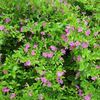
|
Cuphea, Dwarf Mexican HeatherBotanical Name: Cuphea hyssopifolia
Quick growing Mexican native perennial that reaches only twelve inches tall and wide returning in the spring if mulched heavily. Small attractive purple flowers appear in the early summer that stay till winter. Attracts bees and butterflies easily. [ More Info ]
|
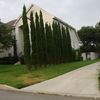
|
Cypress, ItalianBotanical Name: Cupressus sempervirens
Italian Cypress stands as an iconic and striking addition to the Texas landscape, offering a host of benefits for gardeners seeking elegance and structure in their outdoor spaces. Renowned for its stately, columnar form, this evergreen conifer provides a vertical accent that adds height and drama to gardens across the state. With its exceptional cold tolerance, Italian Cypress thrives in the diverse climates of Texas, enduring both the intense heat of summer and occasional winter frosts with ease…except for the 2021 freeze which did unfortunately kill many over the state. Its ability to maintain its deep green foliage year-round ensures a constant source of color and texture in the landscape, enhancing the visual appeal of gardens, parks, and urban spaces alike. Italian Cypress prefers well-draining soils with a slightly acidic to neutral pH level, though it can tolerate a range of soil types commonly found in Texas, including sandy loams and clay soils. This adaptability to varying soil conditions makes it a versatile choice for landscaping projects throughout the state, from coastal regions to inland areas. Its ability to withstand periods of drought once established further enhances its suitability for water-conscious gardeners in Texas, contributing to sustainable landscape practices and water conservation efforts. Its dense foliage provides privacy, noise reduction, and wind protection, making it particularly well-suited for urban and suburban landscapes in Texas. With its cold tolerance, adaptable soil preferences, and versatility in pruning, Italian Cypress stands as an enduring and timeless choice for enhancing the beauty and functionality of gardens throughout the Lone Star State. [ More Info ]
|
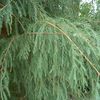
|
Cypress, MontezumaBotanical Name: Taxodium mucronatum
Native to Mexico and the Rio Grande region of Texas, the Montezuma Cypress—also called Sabino or Ahuehuete—is Mexico's national tree, with a notable specimen, "El Árbol del Tule" in Santa Maria, estimated to be over 2,000 years old. This hardy tree is an excellent alternative to the Bald Cypress as it holds its foliage better during cooler weather and can remain evergreen in southern Texas. Known for its adaptability, the Montezuma Cypress thrives in riverbeds and standing water but is also surprisingly tolerant of drought, making it suitable for a variety of Texas landscapes. Fast-growing and capable of reaching 50–80 feet in height, this cypress develops a broad, spreading crown with graceful, weeping branches covered in soft, needle-like leaves. Its foliage has a feathery, delicate look from a distance, and the tree’s bark, a tan to brown color with a slightly shredded texture, adds visual interest. When planted in wet areas, the tree produces unique “knees” that are characteristic of Taxodium cypresses, making it a striking choice for waterfront or low-lying areas. Montezuma Cypress has minimal maintenance needs once established and is well-suited to Texas’s varied soil types, from clay to sandy soils. It’s resilient to pests and diseases, and while young trees are often staked in nurseries due to their initially weak wood, the mature tree is both sturdy and adaptable. The canopy also serves as valuable habitat for birds, adding to its appeal for natural landscapes or conservation efforts. With its majestic form, cultural significance, and versatility, Montezuma Cypress makes an ideal choice as a focal point in parks, large gardens, and along bodies of water. Its adaptability to different soil and moisture levels, coupled with its low maintenance, ensures it will remain a valuable addition to Texas landscapes for years to come. [ More Info ]
|
